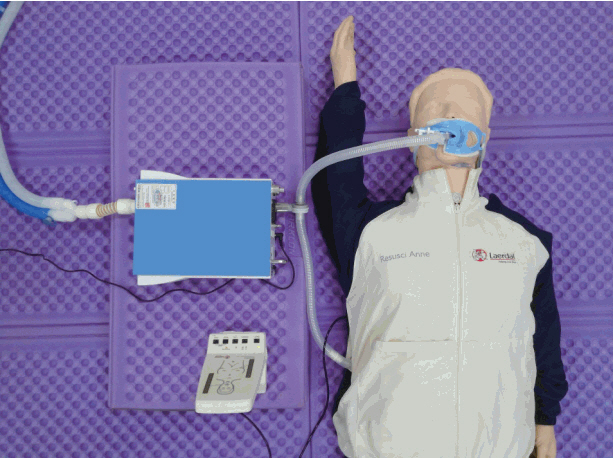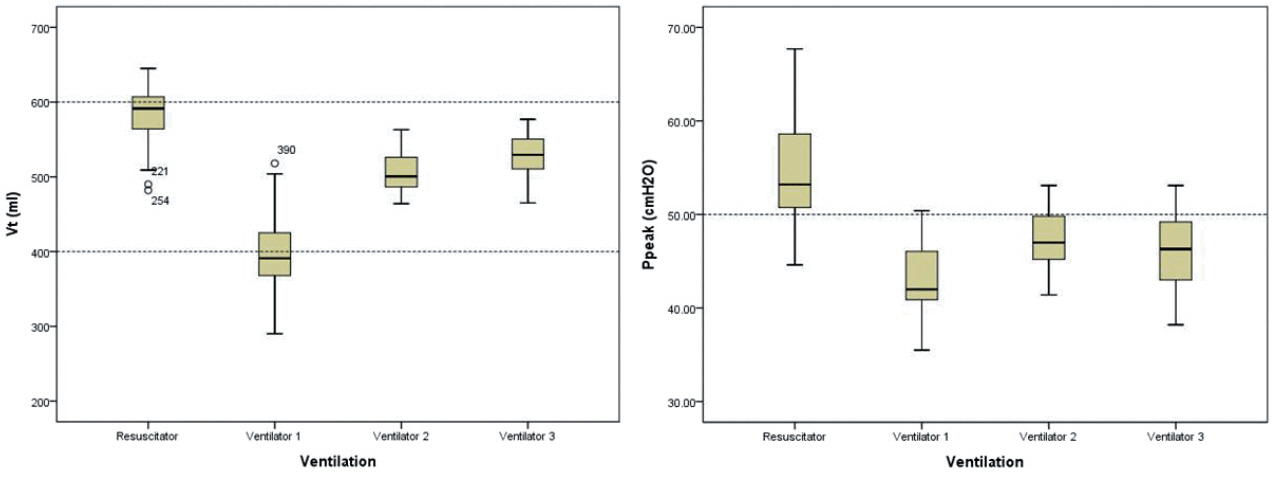Korean J Crit Care Med.
2015 May;30(2):89-94. 10.4266/kjccm.2015.30.2.89.
The Adequacy of a Conventional Mechanical Ventilator as a Ventilation Method during Cardiopulmonary Resuscitation: A Manikin Study
- Affiliations
-
- 1Department of Emergency Medicine, College of Medicine, Chungnam National University Hospital, Daejeon, Korea. rs0505@cnuh.co.kr
- 2Intensivist of Regional Emergency Medical Center, College of Medicine, Chungnam National University Hospital, Daejeon, Korea.
- KMID: 2227669
- DOI: http://doi.org/10.4266/kjccm.2015.30.2.89
Abstract
- BACKGROUND
We conducted this study to verify whether a mechanical ventilator is adequate for cardiopulmonary resuscitation (CPR).
METHODS
A self-inflating bag resuscitator and a mechanical ventilator were used to test two experimental models: Model 1 (CPR manikin without chest compression) and Model 2 (CPR manikin with chest compression). Model 2 was divided into three subgroups according to ventilator pressure limits (P(limit)). The self-inflating bag resuscitator was set with a ventilation rate of 10 breaths/min with the volume-marked bag-valve procedure. The mode of the mechanical ventilator was set as follows: volume-controlled mandatory ventilation of tidal volume (Vt) 600 mL, an inspiration time of 1.2 seconds, a constant flow pattern, a ventilation rate of 10 breaths/minute, a positive end expiratory pressure of 3 cmH2O and a maximum trigger limit. Peak airway pressure (P(peak)) and Vt were measured by a flow analyzer. Ventilation adequacy was determined at a Vt range of 400-600 mL with a P(peak) of < or = 50 cmH2O.
RESULTS
In Model 1, Vt and P(peak) were in the appropriate range in the ventilation equipments. In Model 2, for the self-inflating bag resuscitator, the adequate Vt and P(peak) levels were 17%, and the P(peak) adequacy was 20% and the Vt was 65%. For the mechanical ventilator, the adequate Vt and P(peak) levels were 85%; the P(peak) adequacy was 85%; and the Vt adequacy was 100% at 60 cmH2O of P(limit).
CONCLUSIONS
In a manikin model, a mechanical ventilator was superior to self-inflating bag resuscitator for maintaining adequate ventilation during chest compression.
Keyword
MeSH Terms
Figure
Cited by 1 articles
-
Effects of Changes in Inspiratory Time on Inspiratory Flowrate and Airway Pressure during Cardiopulmonary Resuscitation: A Manikin-Based Study
Jung Ju Lee, Su Yeong Pyo, Ji Han Lee, Gwan Jin Park, Sang Chul Kim, Hoon Kim, Suk Woo Lee, Young Min Kim, Hyun Seok Chai
Kosin Med J. 2021;36(2):100-108. doi: 10.7180/kmj.2021.36.2.100.
Reference
-
References
1. McInnes AD, Sutton RM, Orioles A, Nishisaki A, Niles D, Abella BS, et al. The first quantitative report of ventilation rate during in-hospital resuscitation of older children and adolescents. Resuscitation. 2011; 82:1025–9.
Article2. Aufderheide TP, Lurie KG. Death by hyperventilation: a common and life-threatening problem during cardiopulmonary resuscitation. Crit Care Med. 2004; 32(9 Suppl):S345–51.
Article3. Park SO, Shin DH, Baek KJ, Hong DY, Kim EJ, Kim SC, et al. A clinical observational study analysing the factors associated with hyperventilation during actual cardiopulmonary resuscitation in the emergency department. Resuscitation. 2013; 84:298–303.
Article4. Kern KB, Stickney RE, Gallison L, Smith RE. Metronome improves compression and ventilation rates during CPR on a manikin in a randomized trial. Resuscitation. 2010; 81:206–10.
Article5. Abella BS, Edelson DP, Kim S, Retzer E, Myklebust H, Barry AM, et al. CPR quality improvement during in-hospital cardiac arrest using a real-time audiovisual feedback system. Resuscitation. 2007; 73:54–61.
Article6. Edelson DP, Litzinger B, Arora V, Walsh D, Kim S, Lauderdale DS, et al. Improving in-hospital cardiac arrest process and outcomes with performance debriefing. Arch Intern Med. 2008; 168:1063–9.
Article7. Edelson DP, Eilevstjønn J, Weidman EK, Retzer E, Hoek TL, Abella BS. Capnography and chest-wall impedance algorithms for ventilation detection during cardiopulmonary resuscitation. Resuscitation. 2010; 81:317–22.
Article8. Maertens VL, De Smedt LE, Lemoyne S, Huybrechts SA, Wouters K, Kalmar AF, et al. Patients with cardiac arrest are ventilated two times faster than guidelines recommend: an observational prehospital study using tracheal pressure measurement. Resuscitation. 2013; 84:921–6.
Article9. O’Neill JF, Deakin CD. Do we hyperventilate cardiac arrest patients? Resuscitation. 2007; 73:82–5.
Article10. Weiss SJ, Ernst AA, Jones R, Ong M, Filbrun T, Augustin C, et al. Automatic transport ventilator versus bag valve in the EMS setting: a prospective, randomized trial. South Med J. 2005; 98:970–6.
Article11. Johannigman JA, Branson RD, Johnson DJ, Davis K Jr, Hurst JM. Out-of-hospital ventilation: bag--valve device vs transport ventilator. Acad Emerg Med. 1995; 2:719–24.
Article12. Salas N, Wisor B, Agazio J, Branson R, Austin PN. Comparison of ventilation and cardiac compressions using the Impact Model 730 automatic transport ventilator compared to a conventional bag valve with a facemask in a model of adult cardiopulmonary arrest. Resuscitation. 2007; 74:94–101.
Article13. Cho YC, Cho SW, Chung SP, Yu K, Kwon OY, Kim SW. How can a single rescuer adequately deliver tidal volume with a manual resuscitator? An improved device for delivering regular tidal volume. Emerg Med J. 2011; 28:40–3.
Article14. Wenzel V, Keller C, Idris AH, Dörges V, Lindner KH, Brimacombe JR. Effects of smaller tidal volumes during basic life support ventilation in patients with respiratory arrest: good ventilation, less risk? Resuscitation. 1999; 43:25–9.
Article15. Dörges V, Ocker H, Hagelberg S, Wenzel V, Idris AH, Schmucker P. Smaller tidal volumes with room-air are not sufficient to ensure adequate oxygenation during bag-valve-mask ventilation. Resuscitation. 2000; 44:37–41.
Article16. Dörges V, Ocker H, Hagelberg S, Wenzel V, Schmucker P. Optimisation of tidal volumes given with self-inflatable bags without additional oxygen. Resuscitation. 2000; 43:195–9.
Article17. Neumar RW, Otto CW, Link MS, Kronick SL, Shuster M, Callaway CW, et al. Part 8: adult advanced cardiovascular life support: 2010 American Heart Association Guidelines for Cardiopulmonary Resuscitation and Emergency Cardiovascular Care. Circulation. 2010; 122(18 Suppl 3):S729–67.18. Langhelle A, Sunde K, Wik L, Steen PA. Arterial bloodgases with 500- versus 1000-ml tidal volumes during out-of-hospital CPR. Resuscitation. 2000; 45:27–33.
Article19. Dorph E, Wik L, Steen PA. Arterial blood gases with 700 mL tidal volumes during out-of-hospital CPR. Resuscitation. 2004; 61:23–7.
Article20. Yannopoulos D, Aufderheide TP, Gabrielli A, Beiser DG, McKnite SH, Pirrallo RG, et al. Clinical and hemodynamic comparison of 15:2 and 30:2 compression-to-ventilation ratios for cardiopulmonary resuscitation. Crit Care Med. 2006; 34:1444–9.
Article21. Yannopoulos D, Sigurdsson G, McKnite S, Benditt D, Lurie KG. Reducing ventilation frequency combined with an inspiratory impedance device improves CPR efficiency in swine model of cardiac arrest. Resuscitation. 2004; 61:75–82.
Article22. Aufderheide TP, Sigurdsson G, Pirrallo RG, Yannopoulos D, McKnite S, von Briesen C, et al. Hyperventilation-induced hypotension during cardiopulmonary resuscitation. Circulation. 2004; 109:1960–5.
Article23. Yannopoulos D, Tang W, Roussos C, Aufderheide TP, Idris AH, Lurie KG. Reducing ventilation frequency during cardiopulmonary resuscitation in a porcine model of cardiac arrest. Respir Care. 2005; 50:628–35.24. Deakin CD, Nolan JP, Soar J, Sunde K, Koster RW, Smith GB, et al. European Resuscitation Council Guidelines for Resuscitation 2010 Section 4. Adult advanced life support. Resuscitation. 2010; 81:1305–52.
Article25. Theres H, Binkau J, Laule M, Heinze R, Hundertmark J, Blobner M, et al. Phase-related changes in right ventricular cardiac output under volume-controlled mechanical ventilation with positive end-expiratory pressure. Crit Care Med. 1999; 27:953–8.
Article26. Karlsson T, Stjernström EL, Stjernström H, Norlén K, Wiklund L. Central and regional blood flow during hyperventilation. An experimental study in the pig. Acta Anaesthesiol Scand. 1994; 38:180–6.27. Cheifetz IM, Craig DM, Quick G, McGovern JJ, Cannon ML, Ungerleider RM, et al. Increasing tidal volumes and pulmonary overdistention adversely affect pulmonary vascular mechanics and cardiac output in a pediatric swine model. Crit Care Med. 1998; 26:710–6.
Article
- Full Text Links
- Actions
-
Cited
- CITED
-
- Close
- Share
- Similar articles
-
- Comparison of Compression Adjusted Ventilation to Conventional Ventilation: For Adequate Ventilation Rate During Cardiopulmonary Resuscitation
- ACLS Ventilation Skills-Education Effect of Compression Adjusted Ventilation: A Manikin Study
- Comparison of differences in ventilation volume according to fixation method of I-gel during cardiopulmonary resuscitation in hospital: a study using a simulation manikin
- Effects of Changes in Inspiratory Time on Inspiratory Flowrate and Airway Pressure during Cardiopulmonary Resuscitation: A Manikin-Based Study
- Retention of cardiopulmonary resuscitation skills after hands-only training versus conventional training in novices: a randomized controlled trial



